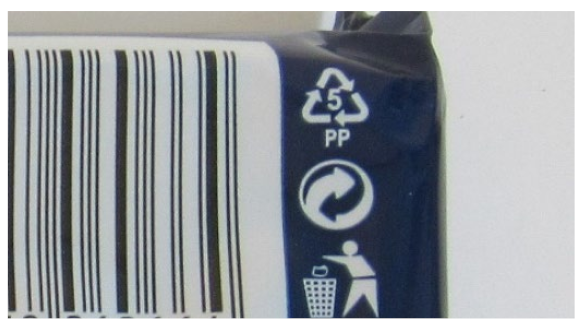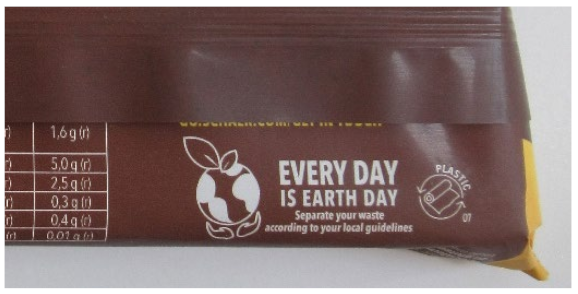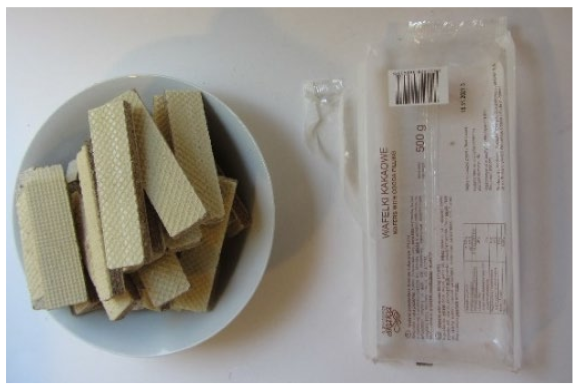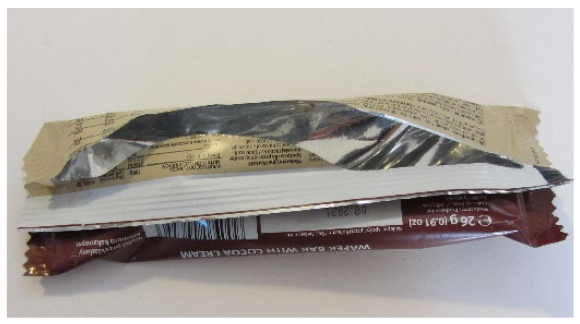(Not) Communicating the Environmental Friendliness of Food Packaging to Consumers—An Attribute- and Cue-Based Concept and Its Application
Abstract
:1. Introduction
2. Materials and Methods
2.1. Attribute–Cue Matrix
2.2. Sampling
2.3. Analysis and Coding
3. Results
3.1. Descriptives
3.2. Heatmap Based on the Attribute–Cue Matrix
4. Discussion and Conclusions
4.1. Potential Reasons for (Not) Communicating the Environmental Friendliness of Packaging Solutions
4.2. Implications for Companies and Policymakers
4.3. Avenues for Further Research and Limitations
Author Contributions
Funding
Acknowledgments
Conflicts of Interest
Appendix A
| Cue | Coding Rule: Coded as Signaling Environmental Friendliness if … | Example |
|---|---|---|
| Color | Packaging was any shade of green |  |
| Label | Recycling code and/or symbol and/or green dot was present |  |
| Image/picture | Nature-related images were present. We excluded any nature-related pictures or graphics that had a direct link to the product and its ingredients, e.g., a cocoa tree |  |
| Haptics/texture | Material was coarse or matte |  |
| Tightly packed | Product was tightly packed (minimum headspace) |  |
| Text | Information on environmental attributes of the packaging was present, e.g., general ecological benefits, appeals for waste treatment or reduction in greenhouse gas emissions |  |
| Weight of the product relative to packaging weight | High product-to-packaging ratio |  |
| Number of packaging levels | No more than one level to open |  |
| Number of packaging waste pieces | Only one waste piece |  |
Appendix B

References
- Yokokawa, N.; Kikuchi-Uehara, E.; Amasawa, E.; Sugiyama, H.; Hirao, M. Environmental analysis of packaging-derived changes in food production and consumer behavior. J. Ind. Ecol. 2019, 23, 1253–1263. [Google Scholar] [CrossRef]
- Surucu-Balci, E.; Tuna, O. Investigating logistics-related food loss drivers: A study on fresh fruit and vegetable supply chain. J. Clean. Prod. 2021, 318, 128561. [Google Scholar] [CrossRef]
- Food and Agriculture Organization of the United Nations. The State of Food and Agriculture: Moving forward on Food Loss and Waste Reduction; Food and Agriculture Organization of the United Nations: Rome, Italy, 2019; Available online: http://www.fao.org/3/ca6030en/ca6030en.pdf (accessed on 2 February 2022).
- Food and Agriculture Organization of the United Nations. Global Food Losses and Food Waste: Extent, Causes and Prevention. Study conducted for the International Congress SAVE FOOD! At Interpack2011 Düsseldorf, Germany; Food and Agriculture Organization of the United Nations: Rome, Italy, 2011; Available online: http://www.fao.org/3/mb060e/mb060e.pdf (accessed on 2 February 2022).
- EUROSTAT. Packaging Waste Statistics. Available online: https://ec.europa.eu/eurostat/statistics-explained/index.php?title=Packaging_waste_statistics (accessed on 21 September 2021).
- European Commission. Waste Statistics—Waste Treatment. Available online: https://ec.europa.eu/eurostat/statistics-explained/index.php?title=Waste_statistics#Waste_treatment (accessed on 2 April 2022).
- Directive (EU) 2019/904 of the European Parliament and of the Council of 5 June 2019 on the Reduction of the Impact of Certain Plastic Products on the Environment (Text with EEA Relevance). 2019. Available online: https://eur-lex.europa.eu/legal-content/DE/ALL/?uri=celex%3A32019L0904 (accessed on 2 April 2022).
- Markets and Markets. Industrial Packaging Market Global Forecast to 2025|MarketsandMarkets. Available online: https://www.marketsandmarkets.com/Market-Reports/industrial-packaging-market-10341323.html (accessed on 23 September 2021).
- Testa, F.; Iovino, R.; Iraldo, F. The circular economy and consumer behaviour: The mediating role of information seeking in buying circular packaging. Bus. Strat. Environ. 2020, 29, 3435–3448. [Google Scholar] [CrossRef]
- Herbes, C.; Beuthner, C.; Ramme, I. How green is your packaging—A comparative international study of cues consumers use to recognize environmentally friendly packaging. Int. J. Consum. Stud. 2020, 44, 258–271. [Google Scholar] [CrossRef]
- Williams, H.; Lindström, A.; Trischler, J.; Wikström, F.; Rowe, Z. Avoiding food becoming waste in households—The role of packaging in consumers’ practices across different food categories. J. Clean. Prod. 2020, 265, 121775. [Google Scholar] [CrossRef]
- Lindh, H.; Olsson, A.; Williams, H. Consumer Perceptions of Food Packaging: Contributing to or Counteracting Environmentally Sustainable Development? Packag. Technol. Sci. 2016, 29, 3–23. [Google Scholar] [CrossRef] [Green Version]
- Escursell, S.; Llorach-Massana, P.; Roncero, M.B. Sustainability in e-commerce packaging: A review. J. Clean. Prod. 2020, 280, 124314. [Google Scholar] [CrossRef]
- Wandosell, G.; Parra-Meroño, M.C.; Alcayde, A.; Baños, R. Green Packaging from Consumer and Business Perspectives. Sustainability 2021, 13, 1356. [Google Scholar] [CrossRef]
- Ketelsen, M.; Janssen, M.; Hamm, U. Consumers’ response to environmentally-friendly food packaging—A systematic review. J. Clean. Prod. 2020, 254, 120123. [Google Scholar] [CrossRef]
- Steenis, N.D.; van der Lans, I.A.; van Herpen, E.; van Trijp, H.C. Effects of sustainable design strategies on consumer preferences for redesigned packaging. J. Clean. Prod. 2018, 205, 854–865. [Google Scholar] [CrossRef]
- Magnier, L.; Mugge, R.; Schoormans, J. Turning ocean garbage into products—Consumers’ evaluations of products made of recycled ocean plastic. J. Clean. Prod. 2019, 215, 84–98. [Google Scholar] [CrossRef]
- De Marchi, E.; Pigliafreddo, S.; Banterle, A.; Parolini, M.; Cavaliere, A. Plastic packaging goes sustainable: An analysis of consumer preferences for plastic water bottles. Environ. Sci. Policy 2020, 114, 305–311. [Google Scholar] [CrossRef]
- Jerzyk, E. Design and Communication of Ecological Content on Sustainable Packaging in Young Consumers’ Opinions. J. Food Prod. Mark. 2016, 22, 707–716. [Google Scholar] [CrossRef]
- Boesen, S.; Bey, N.; Niero, M. Environmental sustainability of liquid food packaging: Is there a gap between Danish consumers’ perception and learnings from life cycle assessment? J. Clean. Prod. 2019, 210, 1193–1206. [Google Scholar] [CrossRef]
- Boz, Z.; Korhonen, V.; Koelsch Sand, C. Consumer Considerations for the Implementation of Sustainable Packaging: A Review. Sustainability 2020, 12, 2192. [Google Scholar] [CrossRef] [Green Version]
- Steenis, N.D.; van Herpen, E.; van der Lans, I.A.; Ligthart, T.N.; van Trijp, H.C. Consumer response to packaging design: The role of packaging materials and graphics in sustainability perceptions and product evaluations. J. Clean. Prod. 2017, 162, 286–298. [Google Scholar] [CrossRef]
- Herbes, C.; Beuthner, C.; Ramme, I. Consumer attitudes towards biobased packaging—A cross-cultural comparative study. J. Clean. Prod. 2018, 194, 203–218. [Google Scholar] [CrossRef]
- Vila-Lopez, N.; Küster-Boluda, I. A bibliometric analysis on packaging research: Towards sustainable and healthy packages. Br. Food J. 2021, 123, 684–701. [Google Scholar] [CrossRef]
- Nguyen, A.T.; Parker, L.; Brennan, L.; Lockrey, S. A consumer definition of eco-friendly packaging. J. Clean. Prod. 2020, 252, 119792. [Google Scholar] [CrossRef]
- Neill, C.L.; Williams, R.B. Consumer preference for alternative milk packaging: The case of an inferred environmental attribute. J. Agric. Appl. Econ. 2016, 48, 241–256. [Google Scholar] [CrossRef] [Green Version]
- Bhardwaj, A. A Study on Consumer Preference Towards Sustainability and Post-Use Consumption of Product Package in Chandigarh. IUP J. Bus. Strategy 2019, 16, 127–146. [Google Scholar]
- Magnier, L.; Schoormans, J. Consumer reactions to sustainable packaging: The interplay of visual appearance, verbal claim and environmental concern. J. Environ. Psychol. 2015, 44, 53–62. [Google Scholar] [CrossRef]
- Testa, F.; Di Iorio, V.; Cerri, J.; Pretner, G. Five shades of plastic in food: Which potentially circular packaging solutions are Italian consumers more sensitive to. Resour. Conserv. Recycl. 2021, 173, 105726. [Google Scholar] [CrossRef]
- Orset, C.; Barret, N.; Lemaire, A. How consumers of plastic water bottles are responding to environmental policies? Waste Manag. 2017, 61, 13–27. [Google Scholar] [CrossRef] [Green Version]
- Koenig-Lewis, N.; Palmer, A.; Dermody, J.; Urbye, A. Consumers’ evaluations of ecological packaging—Rational and emotional approaches. J. Environ. Psychol. 2014, 37, 94–105. [Google Scholar] [CrossRef]
- Koutsimanis, G.; Getter, K.; Behe, B.; Harte, J.; Almenar, E. Influences of packaging attributes on consumer purchase decisions for fresh produce. Appetite 2012, 59, 270–280. [Google Scholar] [CrossRef]
- Sijtsema, S.J.; Onwezen, M.C.; Reinders, M.J.; Dagevos, H.; Partanen, A.; Meeusen, M. Consumer perception of bio-based products—An exploratory study in 5 European countries. NJAS-Wagening. J. Life Sci. 2016, 77, 61–69. [Google Scholar] [CrossRef]
- Monnot, E.; Parguel, B.; Reniou, F. Consumer responses to elimination of overpackaging on private label products. Int. J. Retail Distrib. Manag. 2015, 43, 329–349. [Google Scholar] [CrossRef] [Green Version]
- Lu, S.; Yang, L.; Liu, W.; Jia, L. User preference for electronic commerce overpackaging solutions: Implications for cleaner production. J. Clean. Prod. 2020, 258, 120936. [Google Scholar] [CrossRef]
- Elgaaïed-Gambier, L. Who Buys Overpackaged Grocery Products and Why? Understanding Consumers’ Reactions to Overpackaging in the Food Sector. J. Bus. Ethics 2016, 135, 683–698. [Google Scholar] [CrossRef]
- Monnot, E.; Reniou, F.; Parguel, B.; Elgaaied-Gambier, L. “Thinking Outside the Packaging Box”: Should Brands Consider Store Shelf Context When Eliminating Overpackaging? J. Bus. Ethics 2019, 154, 355–370. [Google Scholar] [CrossRef]
- Elgaaied-Gambier, L.; Monnot, E.; Reniou, F. Using descriptive norm appeals effectively to promote green behavior. J. Bus. Res. 2018, 82, 179–191. [Google Scholar] [CrossRef] [Green Version]
- Magnier, L.; Crié, D. Communicating packaging eco-friendliness. Int. J. Retail Distrib. Manag. 2015, 43, 350–366. [Google Scholar] [CrossRef]
- Scott, L.; Vigar-Ellis, D. Consumer understanding, perceptions and behaviours with regard to environmentally friendly packaging in a developing nation. Int. J. Consum. Stud. 2014, 38, 642–649. [Google Scholar] [CrossRef]
- Jeżewska-Zychowicz, M.; Jeznach, M. Consumers’ behaviours related to packaging and their attitudes towards environment. J. Agribus. Rural. Dev. 2015, 37, 447–457. [Google Scholar]
- Klaiman, K.; Ortega, D.L.; Garnache, C. Consumer preferences and demand for packaging material and recyclability. Resour. Conserv. Recycl. 2016, 115, 1–8. [Google Scholar] [CrossRef]
- Rokka, J.; Uusitalo, L. Preference for green packaging in consumer product choices—Do consumers care? Int. J. Consum. Stud. 2008, 32, 516–525. [Google Scholar] [CrossRef]
- Arboretti, R.; Bordignon, P. Consumer preferences in food packaging: CUB models and conjoint analysis. Br. Food J. 2016, 118, 527–540. [Google Scholar] [CrossRef]
- Olson, J.C.; Jacoby, J. Cue utilization in the quality perception process. In SV—Proceedings of the Third Annual Conference of the Association for Consumer Research; Venkatesan, M., Ed.; Association for Consumer Research: Chicago, IL, USA, 1972. [Google Scholar]
- Lee, E.J.; Bae, J.; Kim, K.H. The effect of environmental cues on the purchase intention of sustainable products. J. Bus. Res. 2020, 120, 425–433. [Google Scholar] [CrossRef]
- Darby, M.R.; Karni, E. Free competition and the optimal amount of fraud. J. Law Econ. 1973, 16, 67–88. [Google Scholar] [CrossRef]
- Zeng, T.; Durif, F.; Robinot, E. Can eco-design packaging reduce consumer food waste? an experimental study. Technol. Forecast. Soc. Chang. 2021, 162, 120342. [Google Scholar] [CrossRef]
- Maesano, G.; Di Vita, G.; Chinnici, G.; Pappalardo, G.; D’Amico, M. The Role of Credence Attributes in Consumer Choices of Sustainable Fish Products: A Review. Sustainability 2020, 12, 10008. [Google Scholar] [CrossRef]
- Rees, W.; Tremma, O.; Manning, L. Sustainability cues on packaging: The influence of recognition on purchasing behavior. J. Clean. Prod. 2019, 235, 841–853. [Google Scholar] [CrossRef]
- Seo, S.; Ahn, H.-K.; Jeong, J.; Moon, J. Consumers’ Attitude toward Sustainable Food Products: Ingredients vs. Packaging. Sustainability 2016, 8, 1073. [Google Scholar] [CrossRef] [Green Version]
- Songa, G.; Slabbinck, H.; Vermeir, I.; Russo, V. How do implicit/explicit attitudes and emotional reactions to sustainable logo relate? A neurophysiological study. Food Qual. Prefer. 2019, 71, 485–496. [Google Scholar] [CrossRef]
- Wensing, J.; Caputo, V.; Carraresi, L.; Bröring, S. The effects of green nudges on consumer valuation of bio-based plastic packaging. Ecol. Econ. 2020, 178, 106783. [Google Scholar] [CrossRef]
- Spack, J.A.; Board, V.E.; Crighton, L.M.; Kostka, P.M.; Ivory, J.D. It’s Easy Being Green: The Effects of Argument and Imagery on Consumer Responses to Green Product Packaging. Environ. Commun. 2012, 6, 441–458. [Google Scholar] [CrossRef]
- Eberhart, A.K.; Naderer, G. Quantitative and qualitative insights into consumers’ sustainable purchasing behaviour: A segmentation approach based on motives and heuristic cues. J. Mark. Manag. 2017, 33, 1149–1169. [Google Scholar] [CrossRef]
- Karana, E. Characterization of ‘natural’ and ‘high-quality’ materials to improve perception of bio-plastics. J. Clean. Prod. 2012, 37, 316–325. [Google Scholar] [CrossRef]
- Ertz, M.; François, J.; Durif, F. How consumers react to environmental information: An experimental study. J. Int. Consum. Mark. 2017, 29, 162–178. [Google Scholar] [CrossRef]
- Deng, X.; Srinivasan, R. When Do Transparent Packages Increase (or Decrease) Food Consumption? J. Mark. 2013, 77, 104–117. [Google Scholar] [CrossRef] [Green Version]
- Confectionery Production. ProSweets 2022 Promises Major Sustainable Packaging Focus—Confectionery Production. Available online: https://www.confectioneryproduction.com/news/37144/prosweets-2022-promises-major-sustainable-packaging-focus/ (accessed on 21 January 2022).
- Dörnyei, K.R. Limited edition packaging: Objectives, implementations and related marketing mix decisions of a scarcity product tactic. J. Consum. Mark. 2020, 37, 617–627. [Google Scholar] [CrossRef]
- Bauer, A.-S.; Leppik, K.; Galić, K.; Anestopoulos, I.; Panayiotidis, M.I.; Agriopoulou, S.; Milousi, M.; Uysal-Unalan, I.; Varzakas, T.; Krauter, V. Cereal and Confectionary Packaging: Background, Application and Shelf-Life Extension. Foods 2022, 11, 697. [Google Scholar] [CrossRef]
- Bauer, A.-S.; Tacker, M.; Uysal-Unalan, I.; Cruz, R.M.S.; Varzakas, T.; Krauter, V. Recyclability and Redesign Challenges in Multilayer Flexible Food Packaging-A Review. Foods 2021, 10, 2702. [Google Scholar] [CrossRef]
- Packaging Insights. Confectionery Packaging Gears up for Circular Economy with Recyclable Plastic, Fiber-Based and Compostable Innovation. Available online: https://www.packaginginsights.com/news/confectionery-packaging-gears-up-for-circular-economy-with-recyclable-plastic-fiber-based-and-compostable-innovation.html (accessed on 21 January 2022).
- Dörnyei, K.R.; Lunardo, R. When limited edition packages backfire: The role of emotional value, typicality and need for uniqueness. J. Bus. Res. 2021, 137, 233–243. [Google Scholar] [CrossRef]
- Chrysochou, P.; Festila, A. A content analysis of organic product package designs. J. Consum. Mark. 2019, 36, 441–448. [Google Scholar] [CrossRef]
- Javier de la Fuente; Stephanie Gustafson; Colleen Twomey; Laura Bix. An Affordance-Based Methodology for Package Design. Packag. Technol. Sci. 2015, 28, 157–171. [Google Scholar] [CrossRef] [Green Version]
- Mayring, P. Qualitative content analysis. In A Companion to Qualitative Research; Flick, U., Kardorff, E., von Steinke, I., Eds.; SAGE: London, UK, 2004; pp. 266–269. ISBN 0761973745. [Google Scholar]
- Krippendorff, K. Content Analysis: An Introduction to Its Methodology; Sage Publications: London, UK, 2018; ISBN 1506395678. [Google Scholar]
- Pauer, E.; Wohner, B.; Heinrich, V.; Tacker, M. Assessing the Environmental Sustainability of Food Packaging: An Extended Life Cycle Assessment including Packaging-Related Food Losses and Waste and Circularity Assessment. Sustainability 2019, 11, 925. [Google Scholar] [CrossRef] [Green Version]
- Otto, S.; Strenger, M.; Maier-Nöth, A.; Schmid, M. Food packaging and sustainability—Consumer perception vs. correlated scientific facts: A review. J. Clean. Prod. 2021, 298, 126733. [Google Scholar] [CrossRef]
- Singh, P.; Wani, A.A.; Langowski, H.-C. (Eds.) Food Packaging Materials: Testing & Quality Assurance; CRC Press Taylor & Francis Group: Boca Raton, FL, USA; London, UK; New York, NY, USA, 2017; ISBN 9781466559943. [Google Scholar]
- Robertson, G.L. Food Packaging: Principles and Practice, 3rd ed.; CRC Press: Boca Raton, FL, USA, 2013; ISBN 9781439862414. [Google Scholar]
- Robertson, G. (Ed.) Food Packaging and Shelf Life: A Practical Guide; CRC Press: Boca Raton, FL, USA; London, UK; New York, NY, USA, 2009; ISBN 9781420078459. [Google Scholar]
- Soroka, W. Fundamentals of Packaging Technology, 5th ed.; Institute of Packaging Professional: Herndon, VI, USA, 2014; ISBN 0615709346. [Google Scholar]
- Wolf, B. Confectionery and Sugar-Based Foods. Reference Module in Food Science; Elsevier: Amsterdam, The Netherlands, 2016; ISBN 978-0-08-100596-5. [Google Scholar]
- Caruana, R.; Glozer, S.; Eckhardt, G.M. ‘Alternative Hedonism’: Exploring the Role of Pleasure in Moral Markets. J. Bus. Ethics 2019, 166, 143–158. [Google Scholar] [CrossRef] [Green Version]
- Cervellon, M.-C.; Shammas, L. The Value of Sustainable Luxury in Mature Markets. J. Corp. Citizsh. 2013, 2013, 90–101. [Google Scholar] [CrossRef]
- Soper, K. Alternative hedonism, cultural theory and the role of aesthetic revisioning. Cult. Stud. 2008, 22, 567–587. [Google Scholar] [CrossRef]
- Soper, K. Towards a sustainable flourishing: Ethical consumption and the politics of prosperity. In Ethics and Morality in Consumption; Routledge: London, UK, 2016; pp. 43–59. ISBN 1315764326. [Google Scholar]
- Bansal, P.; Roth, K. Why companies go green: A model of ecological responsiveness. Acad. Manag. J. 2000, 43, 717–736. [Google Scholar]
- Maziriri, E.T. Green packaging and green advertising as precursors of competitive advantage and business performance among manufacturing small and medium enterprises in South Africa. Cogent Bus. Manag. 2020, 7, 1719586. [Google Scholar] [CrossRef]
- Jiménez-Guerrero, J.F.; Gázquez-Abad, J.C.; Ceballos-Santamaría, G. Innovation in eco-packaging in private labels. Innovation 2015, 17, 81–90. [Google Scholar] [CrossRef]
- European Commission. Initiative on Substantiating Green Claims. Available online: https://ec.europa.eu/environment/eussd/smgp/initiative_on_green_claims.htm (accessed on 19 February 2022).
- Talati, Z.; Egnell, M.; Hercberg, S.; Julia, C.; Pettigrew, S. Food Choice Under Five Front-of-Package Nutrition Label Conditions: An Experimental Study Across 12 Countries. Am. J. Public Health 2019, 109, 1770–1775. [Google Scholar] [CrossRef]
- Julia, C.; Hercberg, S. Big Food’s Opposition to the French Nutri-Score Front-of-Pack Labeling Warrants a Global Reaction. Am. J. Public Health 2018, 108, 318–320. [Google Scholar] [CrossRef]
- Vandevijvere, S. Uptake of Nutri-Score during the first year of implementation in Belgium. Arch. Public Health 2020, 78, 107. [Google Scholar] [CrossRef]
- Schorb, F. Ernährung als Gegenstand politischer Kommunikation. In Ernährungskommunikation: Interdisziplinäre Perspektiven—Theorien—Methoden; Godemann, J., Bartelmeß, T., Eds.; Springer VS: Wiesbaden/Heidelberg, Germany, 2021; pp. 345–359. ISBN 978-3-658-27313-2. [Google Scholar]
- Orset, C.; Monnier, M. How do lobbies and NGOs try to influence dietary behaviour? Rev. Agric. Food Environ. Stud. 2020, 101, 47–66. [Google Scholar] [CrossRef]
- European Commission. Communication from the Commission to the European Parliament, the Council, the European Economic and Social Committee and the Committee of the Regions a European Strategy for Plastics in a Circular Economy. Available online: https://eur-lex.europa.eu/legal-content/EN/TXT/?qid=1516265440535&uri=COM:2018:28:FIN (accessed on 2 April 2022).


| Stage in Packaging Life | Pro-Environmental Attribute | Source |
|---|---|---|
| Material production | Reused packaging | [26,27] |
| Recycled materials | [18,19,28,29,30] | |
| Renewable materials (bio-based) | [18,20,22,23,25,31,32,33] | |
| Packaging production | Less packaging | [34,35,36,37,38] |
| Local/regional production | * | |
| Environmentally friendly production | [25] | |
| Transport and use | Lightweight | * |
| Space-saving | [39] | |
| Post-use | Reusable | [23,25,26,40,41] |
| Recyclable | [19,23,25,29,30,35,42,43] | |
| Bio-degradable | [23,25,29,30,40,44] | |
| General (no specific stage) | Environmentally friendly in general | [40] |
| Consumer Journey | Cue Type | Cue | Source |
|---|---|---|---|
| Point of Sale | Visual (from distance) | Color | [10,39,40] |
| Label/logo | [10,39,51,52] | ||
| Image/picture | [22,53,54] | ||
| Sensory (touching/picking up) | Haptics/texture/material | [10,12,22,25,55,56] | |
| Loose/tight packaging | * | ||
| Informational (reading) | Text | [10,27,28,39,53,54,57] | |
| Consumption | Structural (use-phase) | Product-to-packaging ratio | * |
| Number of packaging levels | * | ||
| Number of packaging waste pieces | [10] |
Publisher’s Note: MDPI stays neutral with regard to jurisdictional claims in published maps and institutional affiliations. |
© 2022 by the authors. Licensee MDPI, Basel, Switzerland. This article is an open access article distributed under the terms and conditions of the Creative Commons Attribution (CC BY) license (https://creativecommons.org/licenses/by/4.0/).
Share and Cite
Dörnyei, K.R.; Bauer, A.-S.; Krauter, V.; Herbes, C. (Not) Communicating the Environmental Friendliness of Food Packaging to Consumers—An Attribute- and Cue-Based Concept and Its Application. Foods 2022, 11, 1371. https://doi.org/10.3390/foods11091371
Dörnyei KR, Bauer A-S, Krauter V, Herbes C. (Not) Communicating the Environmental Friendliness of Food Packaging to Consumers—An Attribute- and Cue-Based Concept and Its Application. Foods. 2022; 11(9):1371. https://doi.org/10.3390/foods11091371
Chicago/Turabian StyleDörnyei, Krisztina Rita, Anna-Sophia Bauer, Victoria Krauter, and Carsten Herbes. 2022. "(Not) Communicating the Environmental Friendliness of Food Packaging to Consumers—An Attribute- and Cue-Based Concept and Its Application" Foods 11, no. 9: 1371. https://doi.org/10.3390/foods11091371
APA StyleDörnyei, K. R., Bauer, A.-S., Krauter, V., & Herbes, C. (2022). (Not) Communicating the Environmental Friendliness of Food Packaging to Consumers—An Attribute- and Cue-Based Concept and Its Application. Foods, 11(9), 1371. https://doi.org/10.3390/foods11091371







